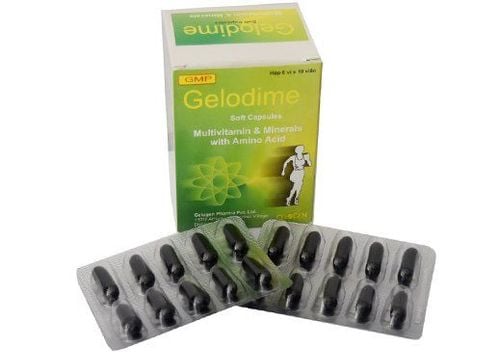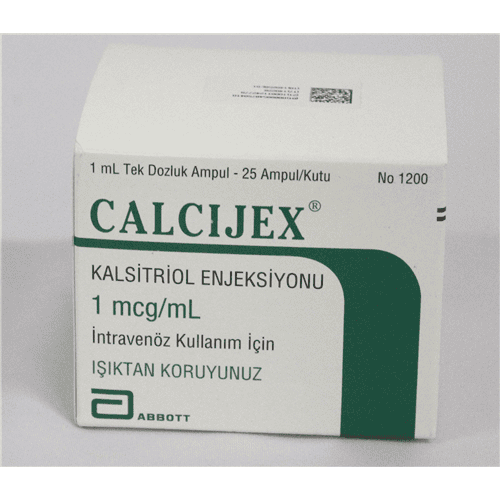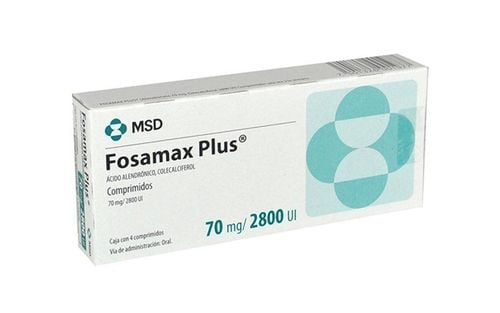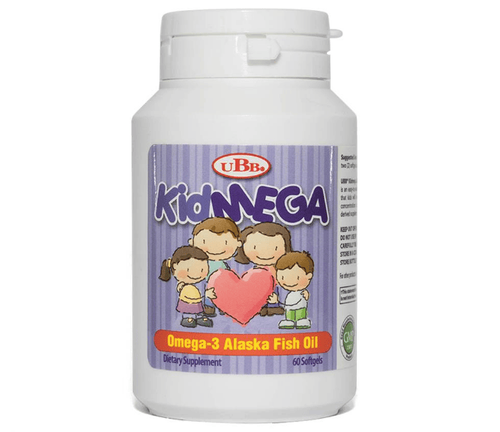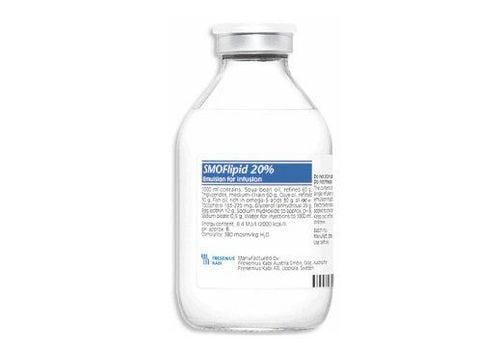This is an automatically translated article.
Calcido is one of the drugs used to treat bone diseases, hypocalcemia, rickets, malnutrition in children. To better understand the drug Calcido the following article will provide you with important information about the drug.
1. What is Calcido?
Calcido is a drug used in the treatment of bone diseases, symptomatic treatment of hypocalcemia, rickets, malnutrition in children.Main ingredients include:
Calcium Gluconate - 500mg. Vitamin D3 (Cholecalciferol) - 200 IU. Excipients include: Tapioca Starch, Wheat Starch, Gelatin, Sodium Starch Gluconate, Magnesium Stearate, Talc Powder, Cellactose 80, Sodium Lauryl Sulfate, Crospovidone, Hydroxypropyl Methylcellulose, Titanium Dioksid, PEG 6000, Nipagin, Nipasol, Food Color Chlorophyll, Tartrazine Color, Ethanol 96%, Purified Water.
2. What are the uses of Calcido?
2.1. Effects Calcido drug is used to treat hypocalcemia in diseases requiring rapid increase in serum calcium ion concentration such as: convulsions due to hypocalcemia in neonates, due to hypoparathyroidism, hypocalcemia due to electrolyte replacement, after surgery for hyperparathyroidism, vitamin D deficiency, alkalosis.
Calcido can be used as an electrolyte replacement, an anti-hyperkalemia and hypomagnesaemia agent. Calcium gluconate injection should only be injected intramuscularly, injected into the myocardium, injected under the skin or should not be allowed to escape from the vessels into the tissues when injected, because it can cause tissue necrosis and or desquamation and abscesses. Oral Calcido is used to treat chronic hypocalcemia and calcium deficiency. Hypocalcemia in the following cases: chronic hypoparathyroidism and pseudohypoparathyroidism, osteomalacia, chronic renal failure, hypocalcemia due to anticonvulsant drugs, or when vitamin D deficiency.
Calcido is also used in Hypocalcemia causes: convulsions, tetany, behavioral and personality disorders, growth retardation and mental retardation, skeletal deformities, most commonly rickets in children and osteomalacia in adults . Changes occur in the shin and lumbar bones, generalized weakness with difficulty walking, and spontaneous fractures. Calcido injection is also used in cases of hypocalcemia due to ethylene glycol poisoning (depending on blood calcium levels), hypocalcemia and hypotension due to systemic hydrofluoric acid toxicity.
2.2. Indications Acute hypocalcaemia (eg infant tetani, due to hypoparathyroidism, hypocalcemic syndrome, remineralization after surgery for hyperparathyroidism, vitamin D deficiency), prevention of hypocalcemia when blood change. Long-term anticonvulsant therapy (increases destruction of vitamin D). Dietary calcium deficiency and especially during periods of increased calcium requirements: growth period, pregnancy, lactation period, the elderly. Hyperkalemia, hypermagnesaemia. Calcium blocker overdose or ethylene glycol poisoning. After a large blood transfusion containing calcium citrate causes hypocalcemia
3. Calcido side effects
Drugs can cause mild digestive disorders: Nausea, vomiting...
Unexpected effects occur when taking high doses of Vitamin D. Taking an overdose of vitamin D3 can cause vitamin D toxicity. The first signs of poisoning are signs and symptoms of hypercalcemia. Hypercalcemia and vitamin D toxicity have some side effects such as:
Nervousness: Weakness, fatigue, somnolence, headache. Gastrointestinal: Anorexia, dry mouth, nausea, constipation, diarrhea. Other manifestations: Tinnitus, ataxia, hypotonia, myalgia, bone pain and excitability.
4. Adverse drug interactions of Calcido
The following drugs inhibit renal calcium excretion, thiazides, clopamide, ciprofloxacin, chlorthalidone, anticonvulsants.
Calcium reduces the absorption of demeclocycline, doxycycline, tetracycline, minocycline, oxytetracycline, tetracycline, enoxacin, fleroxacin, levofloxacin, lomefloxacin, norfloxacin, ofloxacin, pefloxacin, iron, zinc, and other essential minerals.
Calcium increases the cardiotoxicity of glycosides, digitalis because increasing blood calcium concentration will increase the inhibitory effect of Na + - K + - ATPase of cardiac glycosides.
Glucocorticoids, phenytoin reduce calcium absorption from the gastrointestinal tract. Diet with phytate, oxalate reduces calcium absorption and forms difficult-to-absorb complexes. Phosphate, calcitonin, sodium sulfate, furosemide, magnesium, cholestyramine, estrogen, some anticonvulsants also reduce blood calcium. Thiazide diuretics, on the other hand, increase serum calcium levels.
5. How to use Calcido effectively
5.1. Usage: calcium gluconate can be injected, orally or used topically, calculated according to elemental calcium.
5.2. Dosage: Adults: anti-hypocalcemia or nutritional supplements, take 8.8 to 16.5 g (800 - 1500 mg of calcium ion) per day, divided into several small doses. Children: against hypocalcaemia: 500 - 720 mg (45 - 65 mg of calcium ion)/kg/day, divided into several small doses. Injectable dose:
Adults: against acute hypocalcemia or electrolyte replacement, intravenously 970 mg (94.7 mg calcium ion) slowly at a rate not exceeding 5 ml (47.5 mg calcium ion)/ minute. The dose may be repeated if necessary, until tetani is controlled. Bone remineralization syndrome: calcium gluconate diluted in isotonic solution and given as a continuous intravenous infusion at a dose of 0.5 - 1 mg/min (up to 2 mg or more per minute). Anti-hyperkalemia: Intravenous 1 - 2 g (94.7 - 189 mg calcium ion) given slowly at a rate not exceeding 5 ml (47.5 mg calcium ion)/min. Anti-hypermagnesaemia: 1 - 2 g intravenously (94.7 - 189 mg calcium ion) given at a rate not exceeding 5 ml (47.5 mg calcium ion)/min. The recommended dose limit for adults is 15 g (1.42 g ionic calcium)/min). Children: against acute hypocalcaemia: 200 - 500 mg intravenously (19.5 - 48.8 mg of calcium ion) as a single dose, at a rate not exceeding 5 ml (47.5 mg of calcium ion). /minute. Repeat if necessary, until tetani is under control. Newborn blood exchange: 97mg (9.5mg calcium ion) intravenously given after each 100 ml citrate blood exchange. Burns caused by hydrofluoric acid: apply gluconate gel after rinsing with plenty of water. Subcutaneous injection only in this case, works very well in the treatment of hydrofluoric acid burns in the skin. Using a needle size 25 - 30, with a dose of 0.5 ml/cm2 of skin, injected subcutaneously under the burned tissue. Systemic hydrofluoric acid poisoning: add 20 ml of 10% calcium gluconate solution (189 mg of calcium ion) to the first 1 liter of infusion.
5.3. Treatment of Calcido drug overdose Taking high doses can cause hypercalcemia with the risk of kidney stones and kidney failure. If hypercalcaemia persists, it can cause soft tissue calcification, irreversible renal insufficiency. High doses and prolonged use of vitamin D3 cause accumulation of vitamin D leading to increased calcium, blood, fatigue, loss of appetite, loose stools, increased urination and protein.
Currently, there is no separate treatment for drug overdose. It is recommended that you visit your doctor or the nearest medical center for timely treatment and monitoring.
6. Be careful when taking Calcido
The drug should be avoided if there is hypercalcemia or in the case of kidney stones. Care should be taken when administering calcium salts to patients with renal failure, heart disease, or sarcoid disease. The drug can be used by both pregnant and lactating women.
Hope with the above sharing helps you understand how to use Calcido medicine. If you have more questions or problems that need advice, you can talk directly to the doctor who appoints them to get the right advice.
Please dial HOTLINE for more information or register for an appointment HERE. Download MyVinmec app to make appointments faster and to manage your bookings easily.




